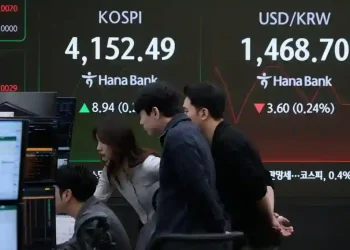Japan Reports $63 Billion Trade Surplus with the U.S. Amid Ongoing Tariff Talks with Trump
Japan has reported a significant $63 billion trade surplus with the United States, even as it faces a broader global trade deficit. According to the Finance Ministry’s latest data released Thursday, Japan’s trade deficit for the fiscal year through March amounted to 5.2 trillion yen ($37 billion), marking the fourth consecutive year of deficits. However, the trade surplus with the U.S. stood out, ballooning to 9 trillion yen ($63 billion).
Exports to the U.S. have long been a contentious issue in trade talks between Japan and the U.S., particularly under President Donald Trump’s administration. Negotiators from Japan are currently in Washington, lobbying against the threat of higher tariffs on Japanese goods. Japan, a key U.S. ally and major investor, employs hundreds of thousands of Americans, making it an integral part of the U.S. economy.
In early April, President Trump announced plans to impose a 24% tariff on imports from Japan as part of broader trade measures against multiple countries. However, following panic in the financial markets, Trump placed a partial 90-day hold on the tariff hike while simultaneously raising existing tariffs on Chinese goods to up to 145%.
Despite the temporary delay, Japan still faces significant tariff challenges. A 10% baseline tariff on various imports remains in place, along with a 25% tax on Japanese car imports, auto parts, and steel and aluminum exports. These duties have already taken a toll and present a challenge for Japanese Prime Minister Shigeru Ishiba’s administration.
In response to the tariff tensions, some analysts speculate that Japan might make surprise concessions to ease trade relations. One potential move could involve increasing imports of American rice—an item of cultural significance in Japan. Historically, Japan has protected its rice industry, but rising domestic prices due to a shortage might prompt a shift in policy.
Despite the trade deficit, Japan’s exports saw a 5.9% increase over the past year, driven by strong shipments of computer chips and vehicles. Meanwhile, imports rose by 4.7%, with the weaker yen making imported goods more expensive.
Another factor contributing to the rise in exports is the recent surge in foreign tourism to Japan. Tourist spending counts as an export, further boosting Japan’s economic performance.
For the month of March, Japan recorded a trade surplus of 544 billion yen ($4 billion), with exports climbing nearly 4% from the previous year. This marked the sixth consecutive month of export gains, though the pace of growth slowed compared to February.
Exports to the U.S. rose by 3%, while shipments to other parts of Asia, such as Hong Kong, Taiwan, and South Korea, grew by 5.5%. On the other hand, exports to China fell, reflecting a shift in trade patterns due to ongoing U.S.-China tariff conflicts.
Min Joo Kang, a senior economist at ING, noted that the rerouting of exports within Asia to avoid U.S. tariffs likely contributed to the increased shipments to neighboring countries. This strategy is a part of Japan’s broader efforts to mitigate the impact of the global trade tensions.
As Japan continues to navigate its complex trade relationships with the U.S., the outcome of these negotiations could shape the future of its economic growth and global trade standing.
This article was rewritten by JournosNews.com based on verified reporting from trusted sources. The content has been independently reviewed, fact-checked, and edited for accuracy, neutrality, tone, and global readability in accordance with Google News and AdSense standards.
All opinions, quotes, or statements from contributors, experts, or sourced organizations do not necessarily reflect the views of JournosNews.com. JournosNews.com maintains full editorial independence from any external funders, sponsors, or organizations.
Stay informed with JournosNews.com — your trusted source for verified global reporting and in-depth analysis. Follow us on Google News, BlueSky, and X for real-time updates.














